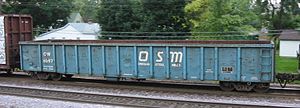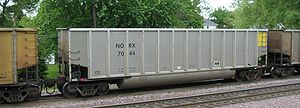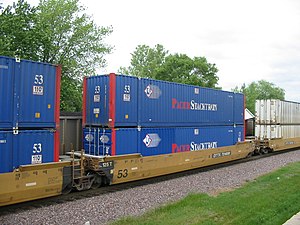|
|
| (9 intermediate revisions by the same user not shown) |
| Line 1: |
Line 1: |
| − | A '''refrigerator car''' (or '''reefer''') is a [[Refrigeration|refrigerated]] [[boxcar]], a piece of [[railroad]] [[rolling stock]] designed to carry perishable freight at specific temperatures.
| + | :''For other uses, see [[Gondola (disambiguation)]]'' |
| − | [[Image:Icing PFE reefers at Oxnard produce packing plant--Spring 1964.jpg|thumb|262px|right|[[Pacific Fruit Express]] refrigerator cars are supplied with fresh ice (spring 1964).]] | + | [[Image:CW 5097 at Rochelle, IL, 20040718.jpg|thumb|300px|A railroad gondola seen at [[Rochelle, Illinois]].]] |
| | + | In [[railroad terminology]], a '''gondola''' is a open-top type of [[rolling stock]] that is used for carrying loose bulk materials. Because of its low side walls, gondolas are used to carry either very dense material, such as [[steel]] plates or coils, or bulky items such as prefabricated pieces of [[rail track]]. |
| | + | |
| | ==History== | | ==History== |
| − | ===Background===
| |
| − | Following the end of the [[American Civil War]], [[Chicago, Illinois]] emerged as a major [[railway]] center for the [[distribution]] of livestock raised on the [[Great Plains]] to Eastern markets. Getting the animals to market required herds to be driven distances of up to 1200 miles (2000 km) to [[railhead]]s in [[Kansas City, Missouri]], whereupon they were loaded into specialized [[stock car]]s and [[transport]]ed live ("on-the-hoof") to regional [[processing]] centers.
| |
| | | | |
| − | Driving cattle across the plains also led to tremendous weight loss, and a number of animals were typically lost along the way. Upon arrival at the local processing facility, livestock were either [[slaughter]]ed by wholesalers and delivered fresh to nearby [[butcher shop]]s for retail sale, smoked, or packed for shipment in barrels of salt.
| + | ==Specialized car types== |
| | | | |
| − | Certain costly inefficiencies were inherent in the process of transporting live animals by rail, particularly the fact that about sixty percent of the animal's mass is inedible. The death of animals weakened by the long drive further increased the per-unit shipping cost.
| + | ==="Bathtub" gondolas=== |
| | + | [[Image:Bathtub gondola at Rochelle.jpg|thumb|A bathtub gondola passing through [[Rochelle, Illinois]], [[May 29]], [[2005]].]] |
| | + | In the second half of the [[20th century]], [[coal]] haulage shifted from open [[hopper car]]s to high-sided gondolas. Using a gondola, the railroads are able to haul a larger amount of coal per car since gondolas do not include the equipment needed for unloading. However, since these cars do not have hatches for unloading the products shipped in them, railroads must use [[rotary car dumper]]s (mechanisms that hold a car against a short section of track as the car and track are slowly rotated upside down to empty the car) or other means to empty them. The term "bathtub" refers to the shape of the car. |
| | | | |
| − | [[Gustavus Franklin Swift]] began looking for a way to ship dressed meats from his packing plant in Chicago to the East. | + | ===Steel coil cars=== |
| | + | [[Image:NS 164420 20050529 IL Rochelle.jpg|thumb|left|A steel coil car owned by [[Norfolk Southern]].]] |
| | | | |
| − | ===Early attempts at refrigerated transport=== | + | ===Container well cars=== |
| − | A number of attempts were made during the mid-1800s to ship [[agriculture|agricultural]] products via rail car. As early as [[1842]] the [[Western Railroad of Massachusetts]] was reported in the [[June 15]] edition of the ''Boston Traveler'' to be experimenting with innovative [[freight car]] designs capable of carrying all types of perishable goods without spoilage. The first refrigerated boxcar or "reefer" entered service in June 1851, on the '''Northern Railroad of New York''' (which later became part of the [[Rutland Railroad]]). This "icebox on wheels" was a limited success in that it was only able to function in cold weather. | + | [[Image:DTTX 724681 20050529 IL Rochelle.jpg|thumb|A portion of a 5-unit container car.]] |
| − |
| + | These specialized gondolas are designed to carry shipping [[container shipping|containers]]. A depressed center section provides a floor which is only inches above the rails. This stabilizes the container by lowering the [[center of gravity]], also allowing double-stacking, which would be impossible if the containers were placed on a [[flatcar]]. Single-unit well cars exist, but 3- and 5-car articulated sets are common. These reduce weight by reducing the number of [[bogie|trucks]] by nearly half, and also reduce the amount of slack in the train. This protects the cargo by reducing the jolts that occur at starting and stopping caused by slack. |
| − | [[Image:Early refrigerator car design circa 1870.jpg|thumb|252px|left|A ''circa'' [[1870]] refrigerator car design. Hatches in the roof provided access to the ice tanks at each end.]]
| |
| − | The first consignment of dressed beef to ever leave the Chicago stockyards did so in [[1857]], and was carried in ordinary [[boxcar]]s retrofitted with bins filled with ice. Placing the meat directly against ice resulted in discoloration and affected the taste, however, and therefore proved to be impractical. During the same period Swift experimented by moving cut meat using a string of ten boxcars which ran with their doors removed, and made a few test shipments to [[New York]] during the winter months over the [[Grand Trunk Railroad]] (GTR). The method proved to too limited to be practical.
| |
| | | | |
| − | [[Detroit, Michigan|Detroit's]] [[William Davis]] patented a [[refrigerator car]] that employed metal racks to suspend the carcasses above a frozen mixture of ice and salt. He sold the design in 1868 to [[George Hammond[[, a Chicago meat-packer, who built a set of cars to transport his products to Boston. The loads had the unfortunate tendency of swinging to one side when the car entered a curve at high speed, and the use of the units was discontinued after several derailments. Finally, in 1878, Swift hired engineer Andrew Chase to design a ventilated car that was well-insulated, and positioned the ice in a compartment at the top of the car, allowing the chilled air to flow naturally downward.
| + | ===Airplane parts cars=== |
| | | | |
| − | The meat was packed tightly at the bottom of the car to keep the [[center of gravity]] low and to prevent the cargo from shifting. Chase's design proved to be a practical solution to providing temperature-controlled carriage of dressed meats, and allowed [[Swift and Company]] to ship their products all over the [[United States]] and internationally.
| + | ===Modalohr road trailer carriers=== |
| − | | + | Specialized rail cars carrying road trailers on a route from France to Italy and vice versa. A deck between the bogies (trucks) pivots (swings), allowing the trailers to be loaded from the sides. For details see [http://www.modalohr.com] . |
| − | Swift's attempts to sell Chase's design to the major railroads were unanimously rebuffed, as the companies feared that they would jeopardize their considerable investments in [[Stock car (rail)|stock cars]], animal pens, and feedlots if refrigerated meat transport gained wide acceptance. In response, Swift financed the initial production run on his own, then – when the [[American]] roads refused his business – he contracted with the GTR (a railroad that derived little income from transporting live cattle) to haul the cars into [[Michigan]] and then eastward through [[Canada]].
| |
| − | | |
| − | In 1880 the [[Peninsular Car Company]] (subsequently purchased by [[ACF]]) delivered to Swift the first of these units, and the Swift Refrigerator Line (SRL) was created. Within a year the Line’s roster had risen to nearly 200 units, and Swift was transporting an average of 3,000 carcasses a week to [[Boston, Massachusetts]]. Competing firms such as [[Armour & Co.]] quickly followed suit. By 1920 the SRL owned and operated 7,000 of the ice-cooled rail cars. The [[General American Transportation Corporation]] would assume ownership of the line in 1930.
| |
| − | | |
| − | [[Image:One of the first cars out of the Detroit plant of American Car & Foundry - Built 1899 for Swift Refrigerator Line - Chicago Historical Society.jpg|thumb|350px|right|A builder's photo of one of the first '''refrigerator cars''' to come out of the [[Detroit]] plant of [[American Car & Foundry]], built in 1899 for the Swift Refrigerator Line.]]
| |
| − | | |
| − | '''Live cattle and dressed beef deliveries to New York ([[tons]]):'''
| |
| − | {| class="toccolours"
| |
| − | |-
| |
| − | |
| |
| − | |align=center | ''(Stock Cars)''
| |
| − | |align=center | ''(Refrigerator Cars)''
| |
| − | |-
| |
| − | |align=center | '''Year
| |
| − | |align=center | '''Live Cattle
| |
| − | |align=center | '''Dressed Beef
| |
| − | |-
| |
| − | |1882
| |
| − | |align=center | 366,487
| |
| − | |align=center | 2,633
| |
| − | |-
| |
| − | |1883
| |
| − | |align=center | 392,095
| |
| − | |align=center | 16,365
| |
| − | |-
| |
| − | |1884
| |
| − | |align=center | 328,220
| |
| − | |align=center | 34,956
| |
| − | |-
| |
| − | |1885
| |
| − | |align=center | 337,820
| |
| − | |align=center | 53,344
| |
| − | |-
| |
| − | |1886
| |
| − | |align=center | 280,184
| |
| − | |align=center | 69,769
| |
| − | |}
| |
| − | | |
| − | <small>The subject cars travelled on the [[Erie Railroad|Erie]], [[Delaware, Lackawanna and Western Railroad|Lackawanna]], [[New York Central Railroad|New York Central]], and [[Pennsylvania Railroad|Pennsylvania]] railroads.</small>
| |
| − | | |
| − | <small>Source: ''Railway Review'', [[January 29]], [[1887]], p. 62.</small>
| |
| − | | |
| − | <gallery>
| |
| − | Image:Reefers-shorty-Armour-Kansas-City-3891-Pullman.jpg|A [[Pullman]]-built "shorty" [[reefer]] bearing the '''Armour Packing Co. - Kansas City''' logo, ''circa'' 1885. Note that the name of the "patentee" was displayed on the car's exterior, a practice intended to "''...impress the shipper and intimidate the competition...''"
| |
| − | | |
| − | Image:Reefers-shorty-ATSF-CM-type-1898-cyc ACF builders photo.jpg|A rare double-door '''refrigerator car''' utilizing the "Hanrahan System of Automatic Refrigeration" as built by [[ACF]], ''circa'' 1898. The car has a single, centrally-located ice bunker.
| |
| − | | |
| − | Image:Pfe722.jpg|An express-style '''refrigerator car''', designed to travel with high-speed [[passenger train]]s.
| |
| − | | |
| − | Image:Reefers-shorty-Anheuser-Busch-Malt-Nutrine ACF builders photo pre-1911.jpg|A pre-1911 "shorty" reefer bearing an advertisement for [[Anheuser-Busch]]'s ''Malt Nutrine'' tonic. The use of similar "billboard" [[advertising]] on [[freight car]]s was banned by the [[Interstate Commerce Commission]] in 1937, and thereafter cars so decorated could no longer be accepted for [[interchange]] between roads.
| |
| − | </gallery>
| |
| − | | |
| − | ===Mechanical refrigeration===
| |
| − | In the latter half of the [[20th century]] mechanical refrigeration began to replace ice-based refrigeration. The mechanical refrigeration units proved their worth in replacing the "armies" of personnel that were no longer needed to re-ice the cars periodically.
| |
| − | | |
| − | <gallery>
| |
| − | Image:ARMN 761511 20050529 IL Rochelle.jpg|A modern '''refrigerator car'''. Note the grill in the lower right where the mechanical refrigeration unit is housed.
| |
| − | | |
| − | Image:Cutaway PFE mechanical.jpg|A cutaway view of a conventional mechanical refrigerator car.
| |
| − | | |
| − | Image:ARMN 110386 detail photo by JS Rybak @ Clarke Ontario Canada April 2005.jpg|State-of-the-art mechanical '''refrigerator car''' designs place the removable, end-mounted refrigeration unit outside of the freight compartment in order to facilitate access for servicing or replacement.
| |
| − | </gallery>
| |
| − | | |
| − | [[Image:Cryx2038-1.jpg|thumb|350px|right|Cryogenic '''refrigerator cars''', such as those owned and operated by [[Cryo-Trans, Inc.]], are still used today to transport frozen food products, including [[french fries]].]]
| |
| − | ===Cryogenic refrigeration===
| |
| − | During the 1990s, a few rail car manufacturers experimented with the use of liquid [[carbon dioxide]] (CO<sub >2</sub >) as a cooling agent. The move was in response to rising fuel costs, and was an attempt to eliminate the standard mechanical refrigeration systems that required periodic maintenance. Several hundred "[[cryogenic]]" '''refrigerator cars''' were placed into service transporting frozen foodstuffs, though they failed to gain wide acceptance.
| |
| | | | |
| | ==References== | | ==References== |
| − | * Boyle, Elizabeth and Rodolfo Estrada (1994) [http://www.oznet.ksu.edu/meatscience/column/industry.htm/ "Development of the U.S. Meat Industry"] — Kansas State University Department of Animal Sciences and Industry.
| |
| − | * Kutner, Jon Jr [http://www.tsha.utexas.edu/handbook/online/articles/view/SS/dis2.html/ "Swift and Company"] — ''The Handbook of Texas Online''.
| |
| − | * Swift & Company (1920) ''The Meat Packing Industry in America''. Swift & Company, Chicago, Illinois.
| |
| − | * Thompson, Anthony W. et al. (1992). ''Pacific Fruit Express''. Signature Press, Wilton, CA. ISBN 1-930013-03-5.
| |
| − | * White, John W. (1986). ''The Great Yellow Fleet''. Golden West Books, San Marino, CA. ISBN 0-87095-091-6.
| |
| − | * White, Jr., John H. (1993). ''The American Railroad Freight Car''. The Johns Hopkins University Press, Baltimore, Maryland. ISBN 0-8018-5236-6.
| |
| − |
| |
| − | ==External links==
| |
| − | * [http://www.sdrm.org/roster/freight/ref21335/index.html Atchison, Topeka, & Santa Fe Railway #21335] — photo and short history of a steel-sheathed "billboard" car.
| |
| − | * [http://www.csrmf.org/doc.asp?id=185 Fruit Growers Express Company #35832] — photos and short history of an example of the wooden ice-type "reefers" commonly placed in service between 1920 and 1940.
| |
| − | * [http://www.sdrm.org/roster/freight/ref56415/index.html Fruit Growers Express Company #56415] — photos and short history of an example of the wooden ice-type "reefers" used in the first half of the 20th century for shipping produce.
| |
| − | * [http://www.sdrm.org/roster/freight/ref11207/index.html Pacific Fruit Express Company #11207] — photo and short history of one of the last ice-type refrigerator cars built.
| |
| − | * [http://www.sdrm.org/roster/freight/re300010/index.html Pacific Fruit Express Company #300010] — photo and short history of one of the first mechanical-type refrigerator cars built.
| |
| | | | |
| − | {{Freight cars}}
| |
| | | | |
| − | [[Category:Cooling technology]]
| + | {{rail-stub}} |
| − | [[Category:Food preservation]]
| + | {{freight cars}} |
| | [[Category:Freight equipment]] | | [[Category:Freight equipment]] |
| | | | |
| − | [[de:Kühlwagen]] | + | [[de:Offener Güterwagen]] |




